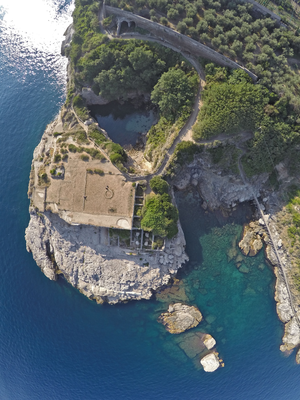Abstract
Since 2014 the Winckelmann-Institut, Department of Classical Archaeology of the Humboldt-University of Berlin, is conducting studies on the Roman Maritime Villa of Capo di Sorrento. New measurements have shown that the well known building has hitherto not been judged appropriately. The aims of the current studies are the development of a complete plan of the architectural remains, the study of the otherwise unknown pars rustica of the Villa and the reconstruction of the Villa using 3D-modelling.
Description
In Roman times, the Gulf of Naples was brimming with luxurious houses along the bay. The Roman Villa of Capo di Sorrento is an example par excellence for the maritime Villae. Located on a protruding rock, surrounded almost completely by the sea, it forms the prominent landmark of the southern end of gulf of Sorrento. The well preserved state of the monument and the results of the research campaigns of 2014 and 2015 allow new assumptions of the original layout of the structure, the design of the decorative program as well as the appearance of the yet lesser known pars rustica. Enormous cisterns on the terraces overlooking the Cape speak for an intensive use of water in both the agricultural and the luxurious part of the Villa. The aforementioned terraces which until today dominate the appearance of the Cape are a key to the understanding of the manner in which the owner and his architect changed and (re-)designed the natural outline of this very special place - a central topic in Roman villegiatura and the respective literary sources.
Institutions
Humboldt-Universität zu Berlin, Excellence Cluster Topoi EXC 264Keywords
knowledge transfer, technology, architecture, constructionDOI
10.17171/2-4Citation
Roman Villa of Capo di Sorrento, 2016, Stephan G. Schmid, Wolfgang Filser, Christoph Klose, Rosaria Perrella, Bernhard Fritsch, Will Kennedy, Angelika Walther, Edition Topoi, DOI: 10.17171/2-4
See all the Edition Topoi Collections










 Stumble It!
Stumble It!

No comments:
Post a Comment